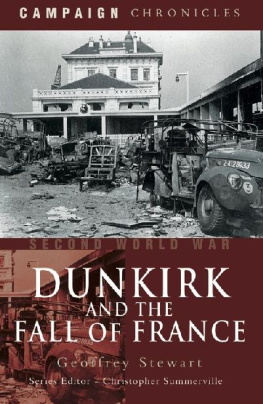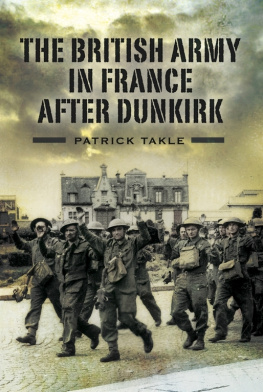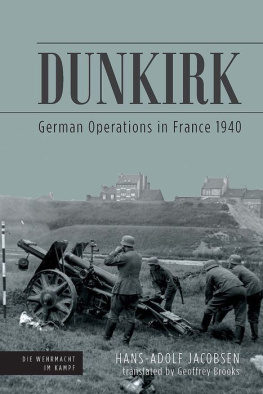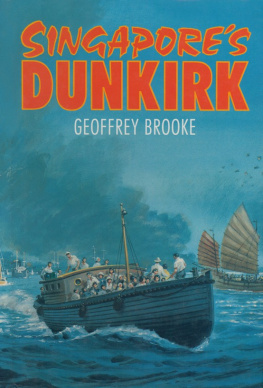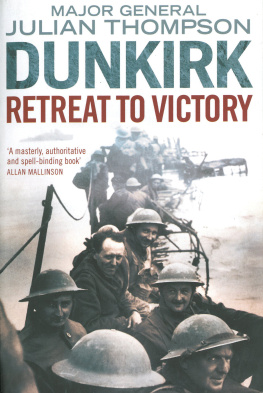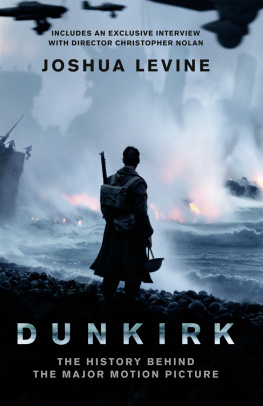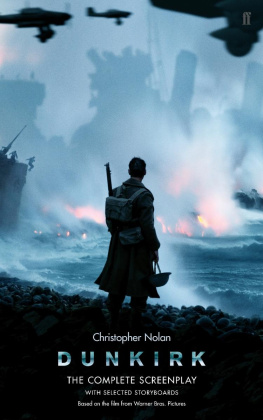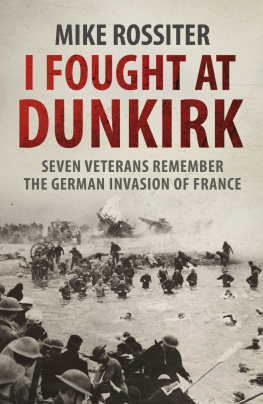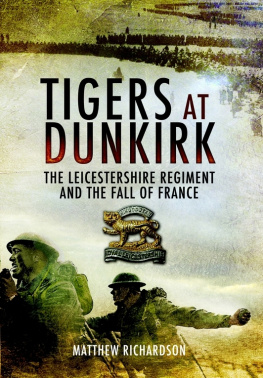Geoffrey Stewart - Dunkirk and the Fall of France
Here you can read online Geoffrey Stewart - Dunkirk and the Fall of France full text of the book (entire story) in english for free. Download pdf and epub, get meaning, cover and reviews about this ebook. year: 2009, publisher: Pen and Sword, genre: History. Description of the work, (preface) as well as reviews are available. Best literature library LitArk.com created for fans of good reading and offers a wide selection of genres:
Romance novel
Science fiction
Adventure
Detective
Science
History
Home and family
Prose
Art
Politics
Computer
Non-fiction
Religion
Business
Children
Humor
Choose a favorite category and find really read worthwhile books. Enjoy immersion in the world of imagination, feel the emotions of the characters or learn something new for yourself, make an fascinating discovery.
- Book:Dunkirk and the Fall of France
- Author:
- Publisher:Pen and Sword
- Genre:
- Year:2009
- Rating:5 / 5
- Favourites:Add to favourites
- Your mark:
- 100
- 1
- 2
- 3
- 4
- 5
Dunkirk and the Fall of France: summary, description and annotation
We offer to read an annotation, description, summary or preface (depends on what the author of the book "Dunkirk and the Fall of France" wrote himself). If you haven't found the necessary information about the book — write in the comments, we will try to find it.
Dunkirk and the Fall of France — read online for free the complete book (whole text) full work
Below is the text of the book, divided by pages. System saving the place of the last page read, allows you to conveniently read the book "Dunkirk and the Fall of France" online for free, without having to search again every time where you left off. Put a bookmark, and you can go to the page where you finished reading at any time.
Font size:
Interval:
Bookmark:

First published in Great Britain in 2008 by
Pen & Sword Military
An imprint of
Pen & Sword Books Ltd
47 Church Street
Barnsley
South Yorkshire
S70 2AS
Copyright Geoffrey Stewart
9781783409150
The right of Geoffrey Stewart to be identified as Author of this work has been asserted by him in accordance with the Copyright, Designs and Patents Act 1988.
A CIP catalogue record for this book is available from the British Library.
All rights reserved. No part of this book may be reproduced or transmitted in any form or by any means, electronic or mechanical including photocopying, recording or by any information storage and retrieval system, without permission from the Publisher in writing.
Typeset in 11pt Sabon by Mac Style, Beverley, East Yorkshire Printed and bound in the UK by CPI
Pen & Sword Books Ltd incorporates the imprints of Pen & Sword Aviation, Pen & Sword Maritime, Pen & Sword Military, Wharncliffe Local History, Pen & Sword Select, Pen & Sword Military Classics, Leo Cooper, Remember When, Seaforth Publishing and Frontline Publishing
For a complete list of Pen & Sword titles please contact
PEN & SWORD BOOKS LIMITED
47 Church Street, Barnsley, South Yorkshire, S70 2AS, England
E-mail: enquiries@pen-and-sword.co.uk
Website: www.pen-and-sword.co.uk
Table of Contents
List of Illustrations
Adolf Hitler
Munich Agreement
Maginot Line
Hermann Hoth
Erich Hpner
Erwin Rommel
Heinz Guderian
Lord Gort
General Billotte
Major General Alexander
Major General Montgomery
Vice Admiral Ramsay
Sir Hugh Dowding
General de Gaulle
German troops cross the Meuse
German tanks deploy
German Landsers goose-step into France
French artillery battery
Columns of refugees
Innocent victims
French civilians flee the fighting
British soldiers advance to the front
Exodus: French refugees on the road
German infantry follow the Panzers
German infantry assault Limburg, Belgium
German artillery in action
German tanks
Panzers on the prowl
Panzer not in its natural habitat
German armour pushing through open country
Knocked out British light tank
Hurrying Heinz Guderian
SS Totenkopf troops on the march
German troops march through subdued French streets
Comrades-in-arms: SS Troopers and Wehrmacht Panzermen
A pause in the fighting
Motorcyclists of Guderians corps
Belgian troops
Churchill and Ramsay
Small boats to the rescue
Operation Dynamo
Dunkirk evacuation
Dunkirk beaches
Rescued by the Navy
The survivors
Homecoming heroes
Capture of the 51st Highland Division
Allied POWs march off the beaches
French POWs
British POWs
Captured at Calais
French POWs await their fate
British corpses
The defeated
Wreckage of war
The victors
SS warriors
Woe to the vanquished
Paris falls
Nazi Swastika flutters over the Arc de Triomphe
Going for broke pays off
Preface
This account does not rest on new and original research but it does reflect a growing perception that the dramatic events of spring 1940 can be looked at afresh. The popular portrait of a decadent France going down shamefully to a superior Nazi Germany has become an enduring legend, most recently finding expression in the phrase, in use in the United States during the Iraq War, that the French were cheese-eating, surrender monkeys. By contrast, the same traditional mythology sanctified Dunkirk as a British triumph, laying the seeds of ultimate victory over the Nazi monster. The roots of both views lie in the wartime needs of a Britain standing alone in June 1940. Churchills famous account of his meeting in Paris on 16 May firmly places the blame on French military incompetence. In the decades after 1945 explanations were sought in either the decadence of French inter-war society, the bitter political divisions of left and right or, most charitably, in the bloodletting of 1914 1918.
Whatever explanation was emphasised, there seemed to be a consensus that France was doomed. Such a view was most graphically offered in the outstanding television series, World at War . The mellifluous yet potent voice of the narrator, Sir Laurence Olivier, gave a new generation of students and viewers the received wisdom in Episode 3, a superior Germany inevitably triumphing over a doomed France.
Part of the problem lies in the proper tendency of historians to look for explanations and seek causes, the more deep-seated the better. The role of chance and human foibles tends to be downplayed. Yet in war, contingent factors are often the decisive ones. Many recent studies of the 1940 campaign have stressed the high risks involved in the German attack. Adam Tooze, in his recent magisterial study of the German war economy, points out:
a close analysis of the mechanics of the Blitzkrieg reveals the astonishing degree of concentration achieved, but also the enormous gamble that Hitler and the Wehrmacht leadership were taking on 10 May. Precisely because it involved such a concentrated use of force, Mansteins plan was a one shot affair. If the initial assault had failed, and it could have failed in many ways, the Wehrmacht as an offensive force would have been spent.Had this occurred, historians would have spent years in analysis of the fundamental weaknesses of the Third Reich and the brittle nature of morale in certain key Wehrmacht units, instead of doing this to the Third Republic and its army. Many French units fought heroically at various times in the campaign. Some German units displayed panic and pessimism. This was easy to understand, as shells from German tanks bounced harmlessly off the heavily armoured French Char B tanks. The war was lost by the French largely as a result of a series of touch-and-go encounters, when the actions of individuals and sheer luck influenced the outcome. Certainly mistakes by the French High Command played a part but then the German High Command and Hitler made mistakes at various points. Likewise, the British got away at Dunkirk as a result of a combination of factors, involving luck with the weather, German errors, and dogged French fighting in and around Lille.
When the campaign began on 10 May it is worth remembering that French defeat was not inevitable. Very few on the German side believed a crushing victory was possible, let alone likely. It has been said that only Guderian, Manstein and Hitler were optimistic, but even Hitler at times showed attacks of nerves, indicating that his optimism was fragile. As so often before and later, he was going for broke. This time the gamble paid off. It need not have done.
York 2007
Maps

MAP 1
GERMAN AIRBORNE ASSAULT ON HOLLAND 10 MAY 1940

MAP 2
THE PANZER ASSAULT 10-13 MAY

MAP 3
OPERATIONS AROUND SEDAN 13 MAY

MAP 4
OPERATIONS AROUND DUNKIRK 25 MAY
Next pageFont size:
Interval:
Bookmark:
Similar books «Dunkirk and the Fall of France»
Look at similar books to Dunkirk and the Fall of France. We have selected literature similar in name and meaning in the hope of providing readers with more options to find new, interesting, not yet read works.
Discussion, reviews of the book Dunkirk and the Fall of France and just readers' own opinions. Leave your comments, write what you think about the work, its meaning or the main characters. Specify what exactly you liked and what you didn't like, and why you think so.

